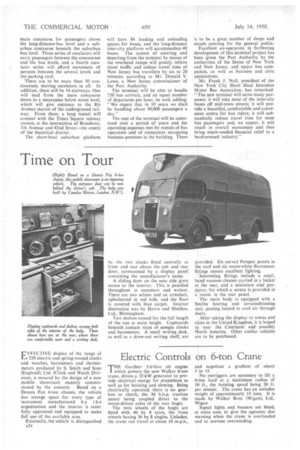Bus Station Costs £8,570,000
Page 43

Page 44

If you've noticed an error in this article please click here to report it so we can fix it.
Thirty Escalators in Fourstorey Terminal Building Now Nearing Completion in New York. Loading Bays for 84 Local Buses and 40 Long-distance Coaches By Harry Wilkin Perry
CONSTRUCTION of a bus terminal in New York, estimated to cost about £8,570,009, is approaching completion. Work began in January, 1949, and the building is scheduled to he in use before the end of this year
The project, planned and financed by the Port of New York Authority through the sale of shares, and to be operated by the Authority as a selfsupporting enterprise, is known as the Port Authority Bus Terminal. Its primary purpose, like that of the Union Motor Truck Terminal described in " The Commercial Motor," dated March 3, is to reduce traffic congestion, which has almost reached saturation point and, secondly, to expedite the movement of vehicles—in this case, suburban and inter-city buses.
The need for the terminal, proposed nearly 12 years ago, is evident from traffic statistics. Each day, 2,500 buses arrive and depart from the State of New Jersey by way of tunnels under the Hudson River. Eighty-five per cent. of, them are used twice daily by about 60,000 city workers. At present they are driven through congested streets to and
from seven individual terminals located in various parts of the heart of the city.
In 1947, the Mayor, Mr. William O'Dwyer, and the New York City Board of Estimate, declared a policy not to approve applications for permission to construct new bus stations, or enlarge or permanently reconstruct present bus terminals in an area approximately one mile wide and two miles long in the middle of the city.
This area embraces the main railway termini on Manhattan Island—Pennsylvania Station and Grand Central Terminal—the principal shopping centre, the theatr& centre and the clothing manufacturing district. Consequently, with one major exception, the principal companies running buses into the city from west of the Hudson River are committed to abandon their private terminals in New York, and to use the new Port Authority bus terminal when it is completed.
The building is located just outside the restricted area, and. covers the entire block between 40th and 41st Streets, and 8th and 9th Avenues, occupying an area 196 ft. by 800 ft. From the west side a winding overhead vehicular ramp will extend to the entrance plaza of the Lincoln Tunnel under the Hudson, and a branch ramp will give access to and from 41st Street for cars and taxicabs, The east part of the ramp has two levels, the lower one for buses entering and leaving the terminal, and the upper leading to the roof, which will provide parking space for about 450 cars and have a public waiting room. Heating plant will keep the ramps free of snow arid lice during winter.
The interior of the terminal has four main levels, the lowest for long-distance inter-city buses and the uppermost for suburban buses. Between these is a
main concourse for passengers above the long-distance-bus level and a suburban concourse beneath the suburban bus level Three series of escalators will carry passengers between the concourses and the bus levels, and a fourth escalator series will afford movement of persons between the several levels and the parking roof.
There are to be more than 30 continuously moving escalators in all. In addition, there will be 16 stairways. One will lead from the main concourse down to a mezzanine below street level, which will give entrance to the 8th Avenue station of the underground railway. From there, a long tunnel will connect with the Times Square subway station, at the intersection of Broadway, 7th Avenue and 42nd Street—the centre of the theatrical .district.
The short-haul suburban platform will have 84 loading and unloading spaces for buses, and the long-distance inter-city platform will accommodate 40 buses. The system of entering and departing from the terminal by means of the overhead ramps will greatly relieve street traffic and reduce travel time of New Jersey bus travellers by six to 20 minutes, according to Mr. Donald V. Lowe, a New Jersey commissioner of the Port Authority.
The terminal will be able to handle 750 bus arrivals, and an equal 'number of departures per hour, he said, adding: "We expect that in 10 years we shall be handling ablaut 90,000 passengers a day."
The cost of the terminal will be amortized over a period of years and the operating expenses met by rentals of bus operators and of companies occupying business premises in the building. There is to be a great number of shops and stands catering for the general public.
Excellent co-operation in furthering development of this terminal project has been given the Port Authority by the authorities of the States of New York and New Jersey, and major bus companies, as well as business and civic associations.
Mr. Frank J. No11, president of the New York City Short Haul Interstate Motor Bus Assocation, has remarked: "The new terminal will serve many purposes: it will take most of the inter-city buses off mid-town streets; it will provide a beautiful, comfortable and convenient centre for bus riders; it will substantially reduce travel time for most bus passengers and, we expect, it will result in overall economies and thus bring much-needed financial relief to a hard-pressed industry." :












































































